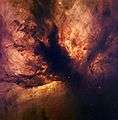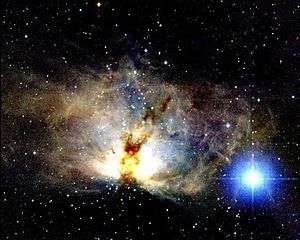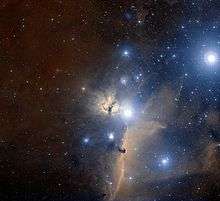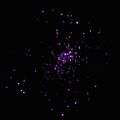Flame Nebula
| Emission nebula | |
|---|---|
 The Flame Nebula (NGC 2024) - based on Chandra X-Ray and Spitzer Infrared images. | |
| Observation data: J2000.0 epoch | |
| Right ascension | 05h 41m 54s |
| Declination | −1° 51′ 0.0″ |
| Distance | 1350[1] ly (415 pc) |
| Apparent magnitude (V) | +2 |
| Apparent dimensions (V) | 30'x30' |
| Constellation | Orion |
| Physical characteristics | |
| Radius | 6 ly |
| Designations | NGC 2024 and Sharpless 277 |
The Flame Nebula, designated as NGC 2024 and Sh2-277, is an emission nebula in the constellation Orion. It is about 900 to 1,500 light-years away.
The bright star Alnitak (ζ Ori), the easternmost star in the Belt of Orion, shines energetic ultraviolet light into the Flame and this knocks electrons away from the great clouds of hydrogen gas that reside there. Much of the glow results when the electrons and ionized hydrogen recombine. Additional dark gas and dust lies in front of the bright part of the nebula and this is what causes the dark network that appears in the center of the glowing gas. The Flame Nebula is part of the Orion Molecular Cloud Complex, a star-forming region that includes the famous Horsehead Nebula.
At the center of the Flame Nebula is a cluster of newly formed stars,[2] 86% of which have circumstellar disks.[3] X-ray observations by the Chandra X-ray Observatory[4][5] show several hundred young stars, out of an estimated population of 800 stars.[6] X-ray and infrared images indicate that the youngest stars are concentrated near the center of the cluster.[7][8]
Gallery
See also
References
- ↑ Meyer, M. R.; et al. (2008). "Star Formation in NGC 2023, NGC 2024, and Southern L1630". In Reipurth, B. Handbook of Star Forming Regions, Volume II: The Southern Sky ASP Monograph Publications. 5. p. 43. ISBN 978-1-58381-670-7.
- ↑ Haisch, K. E. Jr.; Lada, E. A.; Lada, C. J. (2000). "A Near-Infrared L-Band Survey of the Young Embedded Cluster NGC 2024". Astronomical Journal. 120 (2): 1396–1409. arXiv:astro-ph/0006219
 . Bibcode:2000AJ....120.1396H. doi:10.1086/301521.
. Bibcode:2000AJ....120.1396H. doi:10.1086/301521. - ↑ Haisch, K. E. Jr.; et al. (2001). "A Mid-Infrared Study of the Young Stellar Population in the NGC 2024 Cluster". Astronomical Journal. 121 (3): 1512–1521. arXiv:astro-ph/0012482
 . Bibcode:2001AJ....121.1512H. doi:10.1086/319397.
. Bibcode:2001AJ....121.1512H. doi:10.1086/319397. - ↑ Skinner, S.; Gagné, M.; Belzer, E. (2003). "A Deep Chandra X-Ray Observation of the Embedded Young Cluster in NGC 2024". Astrophysical Journal. 598 (1): 375–391. arXiv:astro-ph/0306566
 . Bibcode:2003ApJ...598..375S. doi:10.1086/378085.
. Bibcode:2003ApJ...598..375S. doi:10.1086/378085. - ↑ Broos, P. S.; et al. (2013). "Identifying Young Stars in Massive Star-forming Regions for the MYStIX Project". Astrophysical Journal. 209 (2): 32. arXiv:1309.4500
 . Bibcode:2013ApJS..209...32B. doi:10.1088/0067-0049/209/2/32.
. Bibcode:2013ApJS..209...32B. doi:10.1088/0067-0049/209/2/32. - ↑ Kuhn, M. A.; Getman, K. V.; Feigelson, E. D. (2015). "The Spatial Structure of Young Stellar Clusters. II. Total Young Stellar Populations". Astrophysical Journal. 802: 60. arXiv:1501.05300
 . Bibcode:2015ApJ...802...60K. doi:10.1088/0004-637X/802/1/60.
. Bibcode:2015ApJ...802...60K. doi:10.1088/0004-637X/802/1/60. - ↑ Getman, K. V.; Feigelson, E. D.; Kuhn, M. A. (2014). "Core-Halo Age Gradients and Star Formation in the Orion Nebula and NGC 2024 Young Stellar Clusters". Astrophysical Journal. 787 (2): 109. arXiv:1403.2742
 . Bibcode:2014ApJ...787..109G. doi:10.1088/0004-637X/787/2/109.
. Bibcode:2014ApJ...787..109G. doi:10.1088/0004-637X/787/2/109. - ↑ Nemiroff, R.; Bonnell, J., eds. (10 May 2014). "Inside the Flame Nebula". Astronomy Picture of the Day. NASA. Retrieved February 14, 2015.
External links
| Wikimedia Commons has media related to Flame Nebula. |
- NGC 2024 at Astrophotography
- SIMBAD NGC 2024
- NASA Astronomy Picture of the Day: The Flame Nebula in Infrared (13 July 1999)
- The Flame Nebula on WikiSky: DSS2, SDSS, GALEX, IRAS, Hydrogen α, X-Ray, Astrophoto, Sky Map, Articles and images
Coordinates: ![]() 05h 41m 54s, −01° 51′ 00″
05h 41m 54s, −01° 51′ 00″




